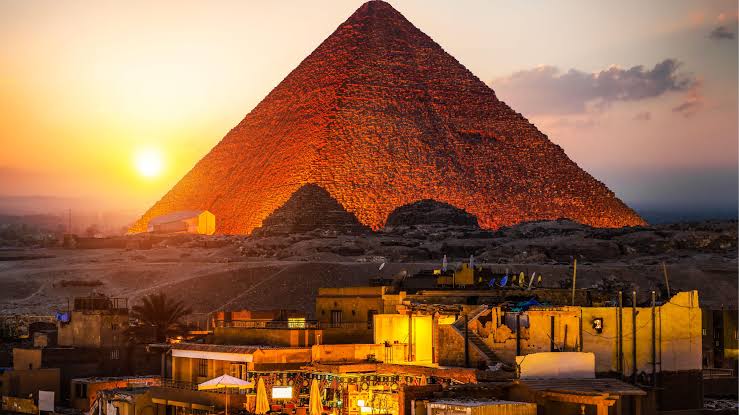Pillars of the Past: Unraveling the Architectural Splendors of Giza

Giza, located on the outskirts of Cairo, Egypt, stands as a timeless testament to the architectural brilliance and ingenuity of ancient civilizations. Home to the iconic Pyramids of Giza, this archaeological treasure trove continues to captivate the world with its monumental structures that have withstood the test of time. In this article, we embark on a journey to explore the architectural wonders of Giza, a site that has mystified and inspired generations.
The Pyramids of Giza – Guardian Sentinels:
The Pyramids of Giza, built over 4,500 years ago during the Fourth Dynasty of the Old Kingdom, remain one of the Seven Wonders of the Ancient World. Comprising three main pyramids—Khufu (Great Pyramid), Khafre, and Menkaure—the Giza Plateau is a testament to the ancient Egyptians’ advanced knowledge of engineering and construction. The Khufu Pyramid, the largest of the three, stands at a staggering height of 146.6 meters (481 feet) and was originally clad in smooth, white Tura limestone, creating a gleaming monument visible from miles away.
The Sphinx – Guardian of Mysteries:
Adjacent to the pyramids lies the enigmatic Sphinx, a colossal limestone statue with the body of a lion and the face of a pharaoh, commonly believed to represent Pharaoh Khafre. Carved from the natural limestone bedrock, the Sphinx stands as a guardian and symbol of both divine power and earthly authority. The Sphinx’s construction techniques and purpose continue to be subjects of scholarly debate, adding an air of mystery to this iconic structure.
Engineering Marvels:
The construction of the pyramids showcases the ancient Egyptians’ unparalleled engineering prowess. The precise alignment of the pyramids with the cardinal points of the compass and the use of sophisticated mathematical and astronomical knowledge demonstrate a level of sophistication that still astounds historians and architects today. The massive stones used in the construction, some weighing several tons, were transported from quarries and assembled with remarkable precision, leaving no gaps between the stones.
The Valley Temple and Mortuary Temples:
Beyond the pyramids and Sphinx, Giza hosts several other architectural marvels. The Valley Temple, associated with the Pyramids of Khafre and Menkaure, showcases intricate stonework and grandiose architecture. The Mortuary Temples, such as the Temple of the Sphinx and the Mortuary Temple of Khufu, served as places of worship and offerings to honor the deceased pharaohs, reflecting the religious and ceremonial aspects of ancient Egyptian culture.
Conservation Challenges and Future Preservation:
Giza’s architectural wonders face the challenges of time, climate, and tourism impact. Efforts to preserve these treasures include ongoing restoration projects, technological advancements, and sustainable tourism practices. Organizations like the Supreme Council of Antiquities in Egypt work tirelessly to safeguard Giza’s heritage for future generations, ensuring that these architectural marvels remain an integral part of our shared human history.
The Pyramids of Giza – Guardian Sentinels:
The Pyramids of Giza, built over 4,500 years ago during the Fourth Dynasty of the Old Kingdom, remain one of the Seven Wonders of the Ancient World. Comprising three main pyramids—Khufu (Great Pyramid), Khafre, and Menkaure—the Giza Plateau is a testament to the ancient Egyptians’ advanced knowledge of engineering and construction. The Khufu Pyramid, the largest of the three, stands at a staggering height of 146.6 meters (481 feet) and was originally clad in smooth, white Tura limestone, creating a gleaming monument visible from miles away.
The Sphinx – Guardian of Mysteries:
Adjacent to the pyramids lies the enigmatic Sphinx, a colossal limestone statue with the body of a lion and the face of a pharaoh, commonly believed to represent Pharaoh Khafre. Carved from the natural limestone bedrock, the Sphinx stands as a guardian and symbol of both divine power and earthly authority. The Sphinx’s construction techniques and purpose continue to be subjects of scholarly debate, adding an air of mystery to this iconic structure.
Engineering Marvels:
The construction of the pyramids showcases the ancient Egyptians’ unparalleled engineering prowess. The precise alignment of the pyramids with the cardinal points of the compass and the use of sophisticated mathematical and astronomical knowledge demonstrate a level of sophistication that still astounds historians and architects today. The massive stones used in the construction, some weighing several tons, were transported from quarries and assembled with remarkable precision, leaving no gaps between the stones.
The Valley Temple and Mortuary Temples:
Beyond the pyramids and Sphinx, Giza hosts several other architectural marvels. The Valley Temple, associated with the Pyramids of Khafre and Menkaure, showcases intricate stonework and grandiose architecture. The Mortuary Temples, such as the Temple of the Sphinx and the Mortuary Temple of Khufu, served as places of worship and offerings to honor the deceased pharaohs, reflecting the religious and ceremonial aspects of ancient Egyptian culture.
Conservation Challenges and Future Preservation:
Giza’s architectural wonders face the challenges of time, climate, and tourism impact. Efforts to preserve these treasures include ongoing restoration projects, technological advancements, and sustainable tourism practices. Organizations like the Supreme Council of Antiquities in Egypt work tirelessly to safeguard Giza’s heritage for future generations, ensuring that these architectural marvels remain an integral part of our shared human history.
Conclusion:
Giza, with its towering pyramids, majestic Sphinx, and awe-inspiring temples, stands as a testament to the ancient Egyptians’ mastery of architecture and engineering. These monumental structures continue to be a source of wonder and inspiration, inviting visitors from around the globe to marvel at the achievements of a civilization that left an indelible mark on the world. Giza’s architectural legacy is not merely a collection of stones but a living testament to the enduring spirit of human creativity and the quest for eternal greatness.








